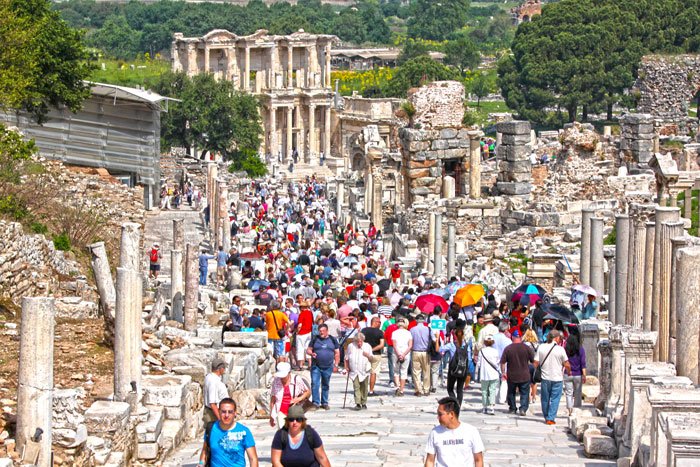Ephesus Guided Tours – the first exhibit one comes to in the museum is the Roman Period House Finds Room, with artifacts from the Slope Houses owned by upper class Ephesians. Among the interesting household items recovered are a bronze Eros with the Dolphin from a 2nd-century fountain and a faded 3rd-century fresco of Socrates. There is also an ithyphallic figurine of Bes, found near the brothel. Of Egyptian origin, Bes was a protector of motherhood and childbearing.
Also in display in the museum is the Ivory Frieze from an upper story of one of the Slope Houses, which depicts the emperor Trajan and his Roman soldiers battling barbarians. Other everyday items include a collection of medical and cosmetic tools, used by the important medical school in Roman Ephesus, and a wall of portraits of Ephesian physicians.
One of the most impressive and illuminating sections in the museum is dedicated to the mother goddess and dominated by two colossal statues of Artemis. One is called “Beautiful Artemis” and dates from the 1st century AD; the other is “Great Artemis” from the 2nd century AD “Ephesus Guided Tours”.
Both Artemis statues feature rows of intriguing protuberances; which most scholars now think are bull testicles; but were previously thought to be breasts or eggs. Regardless, they are all symbols related to fertility. (See Artemis of Ephesus for more details on the goddess and her image.)
Ephesus Guided Tours – beautiful headless Aphrodite
Recoveries from monumental fountains include a beautiful headless Aphrodite, a head of Zeus dating to the 1st century AD; a statue of a youthful Dionysus with a satyr and statues of Dionysus with members of the imperial family; (these last are from the Fountain of Trajan).
Artifacts that are more monumental are displayed in the courtyards, including the pediment from the Temple of Augustus (Isis Temple). It has been reassembled using the original statues; which had been used in the Fountain of Polio after the temple was destroyed. Also out here is a Sarcophagus with Muses from the 3rd century AD and the Ephesus Monument; inscribed with tax regulations, which was issued by Emperor Nero in 62 AD.




